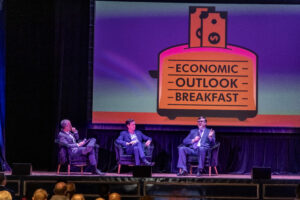Chris Wilson, Smart Furniture CEO
Open concept. Agile office design. Cubicles. Co-working space. Quiet rooms. Sit/stand desks…
If you’re a business owner or human resources manager, you’ve likely spent serious time and energy poring over the best solution for an office environment that fits the budget, boosts company culture and ensures healthy, productive workflow. You’ve considered ergonomics and aesthetics and worked to create a space where your team can comfortably spend 40 hours every week.
So. What do you do now that everyone is working from home?
We’ve talked a lot lately about how the pandemic has changed the game in every aspect of our lives. I can confidently say that in my lifetime, no event has necessitated the all-encompassing, rapid shifts we’ve seen in business operations over the past several months. One thing that keeps resurfacing is the concept of the “new normal.”
We’re not sure what “the other side” looks like, but we can confidently predict that the future of work will look drastically different than it did in early March. To quote Jes Staley of Barclays PLC in a recent edition of The Wall Street Journal:
“The notion of putting 7,000 people in a building may be a thing of the past… We have over 70,000 people working remotely and keeping a very complicated £1.4 trillion balance sheet bank functioning… from their kitchens.”
The truth of this statement is heavy. In a positive light, I find it encouraging that people all over the world are figuring it out — even companies who were adamantly against work-from-home policies pre-pandemic. They’re adapting. But when I picture the reality of that workday, I see people hunched over tables never meant for computers, in chairs never meant for more than sitting for a meal, under lighting never meant to illuminate mile-long spreadsheets.
If we anticipated a return to normal, perhaps we could expect folks to grin and bear it for a while. But the reality is, many of us are here to stay in the work-from-home setting.
If you and your team had just settled on an ideal office setup or refurnished a co-working space for enhanced comfort, you may be feeling deflated about what’s next. But where I see challenges, I also see opportunity — and I’d like to share some insights about what we’ve seen at Smart Furniture.
If you’re considering a stipend…
We’ve heard from employees who have received stipends to fund new office setups — but what we’re realizing is that while stipends are appreciated, some amounts only cover the bare minimum. At the beginning of the pandemic, people were primarily searching for comfortable, ergonomically designed office chairs. Now, since they’re still at home, they’re coming back for things like better desks that aren’t the dining room table, file storage, footrests and other items.
If you’re unsure of a reasonable amount for a stipend, ask team members what they’re lacking and then do research. Consider the average cost of having an employee in an office, and resist
the urge to see that reduction in the budget purely as cost savings. Keeping your team members comfortable and healthy should still be a top priority, and it may be a bigger challenge with teams working from home. People are sitting for longer periods — your teams are no longer walking to grab lunch or coffee, heading to a different area of your office for a meeting, etc. That reduction in movement makes a big impact, and it’s imperative to price out furniture created to perform. You may even consider consulting an office furniture expert who can provide guidance on products that offer the healthiest, most ergonomically designed space for your price point (and yes, we have folks who can help with this at Smart Furniture).
Remember some team members need alternative solutions.
Some members of your team may share small spaces with roommates or family, have kids out of daycare and so on. For those individuals, it’s a good idea to offer an optional office space outside of their homes during flexible hours.
At Smart Furniture, we have several dedicated workstations set up. Each of these spaces has a designated restroom facility and undergoes strict morning and evening disinfecting. Common spaces are subject to social distancing standards. Employees sign up for specific days and spaces on a first-come, first-served basis. Use of these workstations is completely optional, and on a typical day, we see about half of them occupied.
So what’s next for employers?
From our perspective at Smart Furniture, the future of work is forever changed. In fact, we were helping people shift toward remote work long before the COVID-19 pandemic. A study published by the Harvard Business Review highlighted workers’ desire for flexibility in June 2018 — 96% wanted flexibility, and yet only 47% reported enjoying their desired level. A number of organizations, including the Society for Human Resource Management, have recognized flexible scheduling as a top benefit workers want. Data supports this year after year. We knew what workers wanted, but many employers didn’t trust their teams enough to give that to them. Today, however, we’ve heard from workers and employers who have been suddenly forced to adopt remote work policies, and miraculously, things keep going — and in many cases, productivity has increased.
As you plan for the future, I challenge business leaders to resist the urge to only consider “going back to normal,” and instead focus on the immense opportunity ahead. Take this as your chance to innovate, toss antiquated norms and be the employer those 96% of workers want. We rarely have the chance to clear the clutter and focus on the needs of today and tomorrow. Focus on what you’ve learned from this experience, and identify emerging processes that could benefit your organization, your employees and your customers for years to come.
And if you’re looking for someone to help you reimagine the future of work, don’t hesitate to reach out. We’re all in this together.







